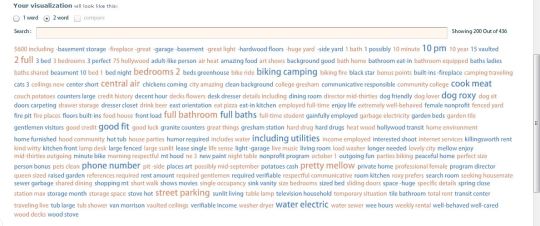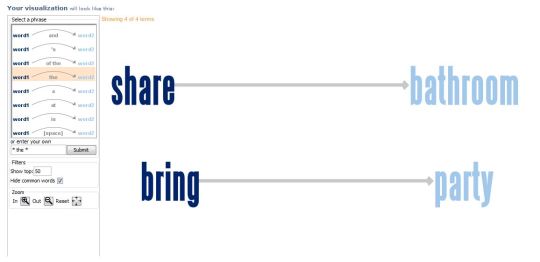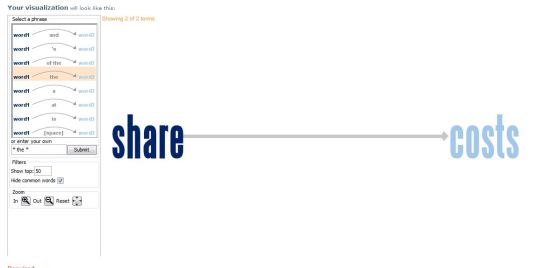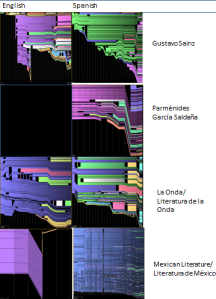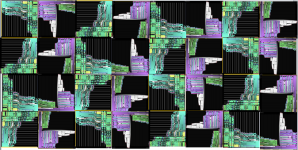Portland Craigslist vs. Santa Barbara Craigslist
Seeing Liz’s post yesterday reminded me that it has been awhile since I have posted here on LuAn. Surely, I thought, there must be something I could include about my current work, as I’ve missed frequenting this friendly space. And while I could dedicate a post about some of my students’ projects from the course I taught this summer or a few of the new visualizations I’ve created about La tumba (if you recall, Agusín’s La tumba to me is like Daniel Deronda to Liz—our default textual subjects), something else came to mind:
My good friend just moved to Portland, Oregon.
A random thought, indeed, but I plan to show how it is connected to this world of Ludic Analytics (or perhaps, how this world has taken over my mind and it now affects how I relate to any and all texts I come across). Since my friend was new to the Portland area, she was looking for a place to live and would send me craigslist ads to get my opinion on possible new roommates. She would also send me some of the ads she found crazy or ridiculous (of which, there were shockingly many…it’s probably more a “craigslist thing” than a “Portland thing”). Then to help out, I began to search the Portland craigslist ads for her, in an effort to find her the perfect place to live in her new city.
It’s been a few years since I have looked for housing, so, I was not up to date on my local craigslist ad situation, but it seemed to me that the Portland posters had some common themes that kept popping up and were distinctly “Portland” compared to the “Santa Barbara” ads to which I was more aware. Primarily, the Portland posters needed evidence that you were employed or had a steady job–which is definitely a good quality in a roommate. It seemed to me, however, that this statement was disproportionally included in the Portland ads. The other commonalities that I perceived from reading the ads were that there were more vegetarians and self-identified “420 friendly” posters in Portland than in Santa Barbara. However, I wondered: is my sense about this correct? I decided to investigate by creating some visualizations of the ads and comparing the results. (Thank you Many eyes).
Keep in mind that this is not the most scientific of experiments, but I was just curious, and I had the tools at the ready (focus more on the ludic here than the analytic). I compared text from the first 11 posts from each city, Portland, Oregon and Santa Barbara, California. In these ads, people were looking for roommates to fill their house. Someday it might be fun to do a more formal analysis (with a bigger sample set, and more rigorous methodologies), but until then, consider these word clouds:
Portland:
Santa Barbara:
“Room” and “House” are (logically) prominent in both clouds. “Kitchen” is more evident in Santa Barbara, while “Work” or “working” does seem to have a higher prevalence in the Portland as I suspected. However, the “420” is actually bigger in the Santa Barbara cloud. School related terms are also more present in the Santa Barbara cloud, perhaps suggesting the large population of students in our much-smaller-than-Portland town.
The clouds did not allude to as much information as I had hoped (despite looking cool) so I decided to check out some more visualizations:
Portland 2-word tag cloud:
Santa Barbara 2 word tag cloud (with phone numbers removed):
Some observations from these visualizations: 1) it’s cheaper to live in Portland ($600 vs $800) 2) People in Portland do in fact “cook meat” and tend to name their dog “Roxy” (or one person with a dog name Roxy mentions said dog numerous times in the same ad) 3) My perception that self-identified “420” posters in Portland were more prevalent appears to be wrong. Of course, one of the caveats of this type of visualization is that it could be misleading. It might say “no” before, and change the meaning, like in the following example of a Santa Barbara phrase net diagram:
Hmm. Interesting. It’s important to Santa Barbara Craigslist posters that you both “Share THE bathroom” and “Bring THE party”. However, upon closer investigation, it’s actually “DON’T bring the pary”:
So, there you go. I guess sometimes data can be misleading (which we already knew).
And just so you know, in Portland it’s important to:
Share THE costs.
Did these visualizations help my friend find a house? No. But they were fun to make and she definitely appreciated the effort. It also solidified in my mind the fact that the process can be just as important as the results, and that it has come to the point where I make visualizations for the amusement of myself and my friends (a good thing? I hope so).
Said friend eventually found a room in a nice house with an amicable roommate; although, unfortunately her new place does not actually come with a dog named Roxy.


